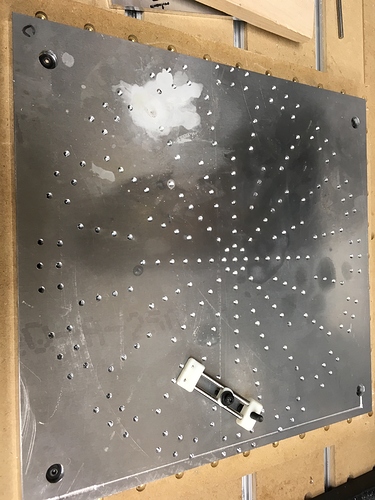I kept track of which holes I was using in a square layout, and it turned out they were in an arc across the part of the board nearest the “bottom” edge. I was trying to come up with a pattern that didn’t “fully” populate the board because I didn’t want to tap that many holes but put them in the places I was using them. I guess I’ll see if I made some good tradeoffs 
The tap was an one I had around out of a kit. I know better. After the first 10-15 holes went ok I should have stopped.
After breaking that one, I switched to one of these ($12)
And one of these (~$18 w/ shipping):
I hand tapped with both to compare. They’re both bottoming taps. I found the Guhring to be easier to use, aligned easier, less torque - the shorter length of the cutting thread (about 5 threads) meant a bit less torque required, which added up by hole 150 or so. The cheaper one did a fine job using the same methods, just more friction (it has 10 or so threads). I used liquid Boelube with both (seemed to behave a little better than kroil and anchorlube, and I still have half a gallon of it to use up). I think next time I do something like this, I’ll seek out these machine taps again, they self clear chips nicely, which the hand taps don’t. With the hand tap, needed to pull it out of each hole at least twice to clear chips but with these I could do each hole in one go.
I still didn’t powertap…no guts, I know.
Here’s how I have been removing the broken tap (maybe someone will find this useful)
- I removed as much as I could by hand. I used a pick and an impact punch and broke out as much as I could below the surface. It broke off essentially just below the surface, so not much more I got out beyond a few tiny shards. I was hoping to get a crack into the web - no luck.
- There are a lot of chips jammed in the flutes (pretty sure this is why it broke). I used the pick to clear out at much as I could, but need to do this repeatedly.
- There was almost no room “in the hole” when I started, but I wiped down the area around with some acetone to keep the lube away.
- Heated the plate - 120 degrees or so, around/below the hole. My garage is ~55 degrees F right now.
- Added a couple drops of acid (I’m using “concrete cleaner” from HD made up of nitric and phosphoric acid, full strength).
- When it stops reacting or seems to “go dry”, soak up/scrape at it with a gun cleaning swab, wipe out the debris in the hole (black iron oxides(?), loose aluminum), scrape at the aluminum chips with a pick, wipe it out again. Every 10 or so passes of this, rub it out with a little acetone, then water, then wipe it dry with a swab. This usually pulls out a little more of the aluminum chips. I stopped with the acetone after the first 2-3 times, doesn’t seem to be making a difference any more.
- go to #4.
No damage to the aluminum so far (but it did clean the area on the surface really well). I’ve “extracted” about 3/8" of it so far… about 7 drops fit in the hole at this point. I’m getting close to the tip of the tap, but whats left is still fully fluted, engaged in the threads, and stuck tight. It goes faster when I’m standing next to it to do the cycle quickly and keep it warm with a torch, and a lot slower when I leave it an hour or two before coming back to it 
I did stick the files up on CutRocket if anyone wants them.

